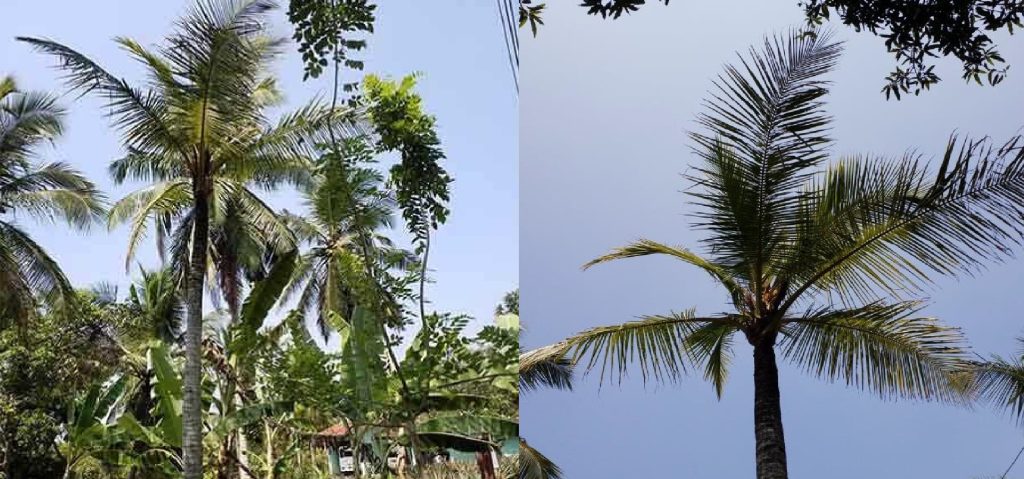Under different environmental conditions, a common issue that affects coconut trees in coconut-growing areas is the premature decline of these trees. This decline occurs in coconut trees growing in both barren and fertile soil, and interestingly, it often affects trees that have previously been productive. This premature decline can be categorized into two main conditions: Leaf Scorch Decline and Tapering.
A.Leaf Scorch Decline

The degradation of coconut leaves is typically observed in coconut trees that are over 15 years old. In this condition, the most prominent feature is the scorching of the leaflets on the lower branches of the coconut tree, which subsequently spreads to both sides of the midrib before causing the leaflets to curl downward. The progression of damage symptoms in a coconut tree experiencing defoliation can be described as follows:
Characteristics of the Intermediate Phase:
⦿ Desiccation and drying of leaves in the lower and mid-story branches of the coconut tree.
⦿ New shoots are short and display a light green colour.
⦿ Reduced fruiting from new coconut flowers.
⦿ Fermented fruits become small and take on an oblong shape.
⦿ Thinning of the trunk begins immediately below the carapace.
⦿ Reduced occurrence of root rot and new root formation.
End-Stage Features:
⦿ The crown area is restricted to a minimal number of branches due to the shedding of dead branches and the emergence of new ones.
⦿ Branches and small inflorescences display a light green color.
⦿ Small and elongated coconuts are visible, and their yield is minimal.
⦿ Fruitless inflorescences become a common feature.
⦿ The trunk notably becomes thinner below the carapace.
In coconut trees in the final stage of defoliation, the new branches at the top are short and pale in colour, yet they do not exhibit signs of wilting. Drying leaves are scattered throughout coconut plantations affected by this condition. The rate at which trees are impacted by this decline can vary from tree to tree. Harvesting typically ceases 2-6 years after the initial symptoms appear, and it may take 8-10 years or more for a tree to ultimately wither and die.
B. Tapering

Degenerative trunk thinning typically occurs in coconut trees over 15 years old. In this condition, the distinguishing features are that the trees that were previously bearing fruit turn light green relatively quickly, and the leaf crown (known as goba) appears divided both up and down, followed by thinning of the trunk immediately below the crown. The progression of symptoms in a tree experiencing trunk thinning can be described as follows:
Characteristics of the Intermediate Phase:
⦿ An asymmetric crown area.
⦿ Newly emerging branches are short and light green.
⦿ Fruits are few and elongated.
⦿ Stem thinning is visible immediately below the stem.
⦿ Very few new roots are formed.
⦿ Early decay sets in.
Features of the final stage:
⦿ The crown is limited to a few small, light green branches.
⦿ Inflorescences are small.
⦿ Minimal fruiting occurs.
⦿ The coconuts formed are oblong in shape.
⦿ Inflorescence fruitlessness becomes a common feature.
⦿ Thinning of the trunk is noticeable below the carapace.
⦿ Extensive root rot occurs.
Trees affected by this condition may be scattered throughout the plantation. It can take up to 8-10 years, and in some cases even longer, for a mature tree to die, with trees becoming barren within 2 to 6 years of displaying symptoms of this degenerative condition.
Reasons?
1. One of the primary reasons for leafing and stem thinning decline is the failure to apply fertilizer in proportion to the elements removed from high-yielding varieties.
2. Neglecting the application of organic fertilizers, which serve as vital sources of trace elements such as sulphur and copper, despite consistent use of primary nutrients like nitrogen, magnesium, potassium, and phosphorus.
3. Long-term deficiency of nitrogen, phosphorus, and magnesium (N, P, Mg), the essential nutrients in a crop, and their non-recovery due to inadequate fertilization.
4. Adverse soil conditions, including:
– Hard, gravelly soil.
– Shallow soil depth (with hard gravel or clay layers close to the surface).
– Clay soils prone to frequent waterlogging or drying out.
– Insect damage to roots.
Late-stage symptoms of both Leaf Scorch Decline (LSD) and Tapering are similar. Therefore, apart from the initial stage, it is difficult to determine which degeneration caused the tree to become thinner. Unfortunately, trees that have experienced these declines cannot be restored once they reach the advanced stage.
Restoration of Prematurely Declined Trees
1. Properly apply fertilizers that provide nitrogen, potassium, magnesium, and phosphorus (N, K, Mg, P) in the correct amounts and at the right time. Additionally, annually adding 20-40 kg of composted chicken manure and 40-60 kg of 1-2 mm coconut charcoal per tree (as little as possible) to the fertilizer circle and thoroughly mixing it with the soil can improve soil texture until the condition is favourable.
2. To prevent leafing and stem thinning conditions, follow these management practices:
⦿ Apply organic fertilizers from the seedling stage.
⦿ Fertilize high-yielding coconut varieties more.
⦿ Apply fertilizer twice a year in specified amounts.
⦿ Implement appropriate moisture conservation and nutrient retention methods when growing coconuts in S4 soil type that is generally
⦿ suitable for coconut cultivation.
⦿ Control harmful soil insects with the guidance of a qualified and experienced officer.


Leave a Reply